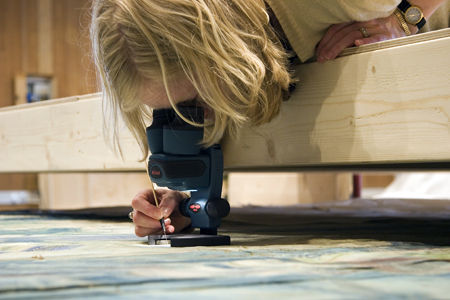Paintings on Rolls – by Eva Storevik Tveit
 The Conservation Project “Paintings on Rolls” started in March 2006 at the Munch Museum. The project encompassed 31 sketches that Munch painted in connection with the decorations for the University Aula in Oslo, during the period 1909–1916. In addition, the project included 15 other drafts from the period 1909-1930 stored on rolls – including eight of which were painted for the first submitted proposal for the Aula decorations in 1910, The Human Mountain. However, this work was rejected by the jury (Pettersen 2008: 846). Among the other seven sketches, there were three that Munch worked on as a proposal for the decoration of the Town Hall in Oslo, which he never completed, while the last four drafts have other motifs. The drafts measure from 142 cm X 130 cm to 450 cm X 1140 cm.
The Conservation Project “Paintings on Rolls” started in March 2006 at the Munch Museum. The project encompassed 31 sketches that Munch painted in connection with the decorations for the University Aula in Oslo, during the period 1909–1916. In addition, the project included 15 other drafts from the period 1909-1930 stored on rolls – including eight of which were painted for the first submitted proposal for the Aula decorations in 1910, The Human Mountain. However, this work was rejected by the jury (Pettersen 2008: 846). Among the other seven sketches, there were three that Munch worked on as a proposal for the decoration of the Town Hall in Oslo, which he never completed, while the last four drafts have other motifs. The drafts measure from 142 cm X 130 cm to 450 cm X 1140 cm.
The sketches are working drafts and were probably never intended to be mounted on stretchers. Many of the them were stored on rolls during Munch’s own lifetime, and were kept like this after his death as well. As many as six canvases were stacked on the same roll with the paint layers facing inward. The diameters of the rolls measured from 6 cm to 30 cm. With a few exceptions the rolls were placed directly on shelves in the Munch Museum’s storage rooms. The aim of the present conservation project has first and foremost been to improve the storage conditions.
Unlike the smaller sketches that could be stored flat in boxes, the largest canvases still had to be stored on rolls. However, the new rolls have larger diameters. In addition, we have used proper packing material, and the rolling method has been improved: the sketches have been rolled with the paint layers facing outward, we have used one roll for each single draft, and a hanging system has been constructed which allows the rolls to be suspended on poles.
With the exception of five sketches, the works had not previously been examined. The existing information proved to be very limited, so documentation regarding the materials and the condition of the sketches was therefore an important aspect. During the course of the project we have discovered new phenomena of Munch’s art and gained new knowledge about his painting technique, materials and methods.
The Munch Museum has now completed the documentation and treatment of 46 drafts, approximately 400 m2 of painted surfaces. More than 18 conservators have been involved in the project which has been an extraordinary one and has offered several unusual challenges that have required a major collaboration between technicians and conservators. The enormous unstretched formats, for instance, had to be treated while lying horizontally. For this, various bridging systems were constructed in order for the conservators to treat the mid sections of the sketches. Owing to Munch’s choice of materials and to the fact that he both painted and kept many of this drafts out of doors, their condition is extremely frail. Given these special circumstances, it was not practical to employ traditional methods of conservation treatment. In addition, the aim to use a minimum of invasive methods was a challenging and instructive one.